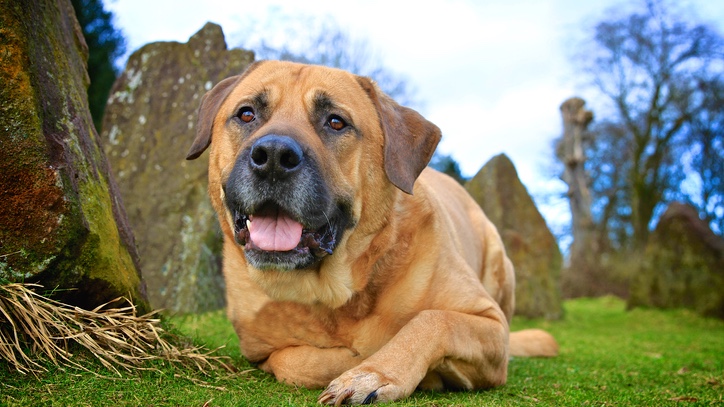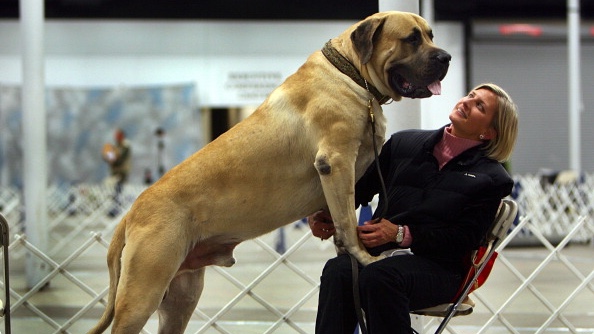English Mastiff vs Bullmastiff: Which breed should you choose?
In this contest, it's English Mastiff vs Bullmastiff – two similar breeds with one big difference. Which will you choose?

English Mastiff vs Bullmastiff is a tricky choice when you're looking for a large, protective dog. These drooly giants are, on the whole, similar in temperament and looks, although there are sufficient differences between them for you to decide which will be a more suitable fit for your home – one of them being obvious since it relates to sheer size.
So, we're going to have to delve deep to work out which you'd rather have around. Would you prefer a largely timid, quiet, calm dog that is more likely to spend its time relaxing? In which case, you'd maybe want to pay attention to an English Mastiff. Or would you like a dog that's a little more boisterous and not so large that they're going to dominate your living space? A Bullmastiff, perhaps?
Whichever you choose, you will find a breed that is a joy to have around, just as we discovered in our Bullmastiff vs Pit Bull head-to-head. Both breeds make great family pets and they are well known for being devoted, loyal, and courageous. They're also sensitive yet potentially headstrong. With that in mind, let the “battle” commence!
English Mastiff vs Bullmastiff: Origins
English Mastiffs are understood to have descended from two extinct breeds: the Pugnaces Britanniae and the Alaunt, mixed with the extinct Alpine Mastiff in the 19th century.
They were originally bred as guard dogs and were also expected to fight wild animals. But when bull-baiting and bear-baiting were prohibited under the UK's Cruelty to Animals Act in 1835, the breed's popularity nosedived to such an extent that, at one point, only one remained in England. Thankfully, they were exported to the United States and, following World War II, began to thrive once more.
Bullmastiffs, on the other hand, are a cross between the English Mastiff and the now-extinct Old English Bulldog – explaining their similarities and differences as you'll discover by reading our seven larger-than-life Bullmastiff facts.
They were developed in the 1860s and became known as the Gamekeeper's Night Dog because they were bred to keep poachers at bay. Over time, they have been bred to be less aggressive and they have since become popular pets, finding themselves in the United States from the 1870s onwards.
English Mastiff vs Bullmastiff: Size and appearance
Put an English Mastiff together in the same room as a Bullmastiff and you may not immediately know which one is which. Both are large, well-built dogs with similar body and head shapes. Both also have V-shaped ears, dark masks, and muzzles as well as similar short-haired coat colors (although only English Mastiffs come in apricot and only Bullmastiffs in red).
But the big difference – aside from a Bullmastiff's shorter muzzle – is that an English Mastiff is the bigger of the two by some distance. You can see this if you meet the 250lb Mastiff who's built like a wrestler. Although the average height of an adult English Mastiff is 30 inches (76cm) tall, which is just three inches (8cm) more than a Bullmastiff, it is certainly noticeable.
More than that, however, is the vast difference in average weight: about 220lbs (100kg) for a male English Mastiff as opposed to 130lb (59kg) for a Bullmastiff. As you can imagine, that makes the English Mastiff the largest of the different types of Mastiff breed. In fact, the English Mastiff is the biggest dog breed on the planet.
Are English Mastiffs more aggressive than Bullmastiffs?
Both breeds are known to be gentle giants and will generally seek to avoid conflict. That doesn't mean they can't be aggressive, however. If either breed isn't sufficiently socialized as a pup or well-trained, then there's no getting around the fact that they have the potential to be dangerous. Indeed, the Bullmastiff has powerful jaws with a bite force of 552psi.
For that reason, neither are really suitable for novice pet parents. Of the two, the Bullmastiff is perhaps more difficult to train due to the breed's stubborn, independent nature and strong desire to seek the upper hand. Yet English Mastiffs need to be socialized earlier and more often to avoid future problems, while Bullmastiffs are less tolerant of other animals.
Even so, they make for cracking family dogs. Once trained and socialized, they are protective, loving, affectionate, and calm. They are patient around children, although they aren't the best around young kids, simply because their size and strength mean they could accidentally knock into a child and potentially cause an injury.
English Mastiff vs Bullmastiff: Exercise needs

All dogs need to be exercised and in the case of these two breeds, an hour each day split over a couple of sessions will suffice. In fact, both the English Mastiff and Bullmastiff will thank you for not over-exerting them since both are rather lazy. While a Bullmastiff is more playful, they'd both prefer to hang around your house rather than traipse around the streets.
You can't really overdo exercise for either breed anyway, particularly when they are puppies. Their size and weight have the potential to cause damage to bones and joints. What's more, Bullmastiffs have a short muzzle and that makes it more difficult for them to breathe while also making them more susceptible to excessive heat. Simply give them access to the best dog toys, play tug-of-war, and go for those short bursts of exercise and it's job done.
English Mastiff vs Bullmastiff: Grooming
Both of these breeds are easy to groom so if you've ever wondered, 'how much does it cost to own a Bullmastiff', for instance, then at least you don't need to worry about grooming adding to the bills. Indeed, they only require regular brushing of their short coats using one of the best dog brushes.
Of the two breeds, the English Mastiff is the bigger shedder and, if you don't keep on top of it, you'll find hairs everywhere all year round – particularly so in the summer and the fall.
The main concern is drooling. Both drip excessively from their mouths and you'll start to dread them shaking their heads. You're definitely going to have to carry a towel around or at least have a pack of tissues to hand.
Wiping their face starts to become second nature after a while but if you're precious about your home, it's not ideal. Other than that, just keep their teeth clean and invest in the best dog nail clippers.
Are English Mastiffs smarter than Bullmastiffs?
Both English Mastiffs and Bullmastiffs are intelligent but you may not think so when you're training them. Sometimes they will become unresponsive and although that could be mistaken for them not having a clue what you're asking them to do, that couldn't be further from the truth.
In reality, these breeds know what you want – they're just stubborn and getting bored, which is why training is best carried out in short bursts. Since Bullmastiffs are even more independently minded (and a tiny bit smarter), they need a greater amount of consistency in their training. Without it, they will push the boundaries and their minds will wander.
At the same time, you need to keep the breeds mentally stimulated, so try these 12 great brain games for dogs. When training either breed, positive reinforcement also works best so buy some of the best dog treats and take things slowly, showing patience at every step.
PetsRadar Newsletter
Get the best advice, tips and top tech for your beloved Pets

David Crookes has been a journalist for almost 30 years and he has written for a host of magazines, newspapers, websites and books including the World of Animals Annual, BBC Earth, Live Science, The Independent and Tom’s Guide.
Born in England, he lives with two cats but he’s also keenly interested in the differences between the huge number of dog breeds – in fact, you can read many of his breed guides that he’s written in collaboration with vets here on PetsRadar.
With a lifelong passion for technology, too, he’s always on the lookout for useful devices that will allow people to keep their pets happier and healthier, and provide them more time to spend together.
David has a degree from Durham University, as well as postgraduate diploma in journalism from the University of Central Lancashire.
